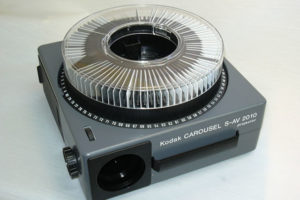B y Bill Katzenstein
y Bill Katzenstein
The International Photographic Society (IPS) celebrates its 50th Anniversary this season. Having been a longstanding member of IPS has enabled me to witness how the introduction of digital technology over the past decade resulted in major changes in IPS photographic competition after some forty years.
Specifically, the introduction of digital photography and electronic image competition (EIC), together with the ease of finessing images through the digital darkroom, have made the creation and submission of high-quality images much easier. Concurrently the maximum number of entries per participant in an evening of competition was decreased from five color slides or prints (both were competed at each meeting) to either three electronic or two print images (presently competed at alternate meetings). The limitation in submissions of competed images followed a large rise in participation after the introduction of electronic image competition, which had extended most IPS meetings well beyond 9pm.
Also over the past decade, the percentage of entries that could win or place in competition was increased from 15% to 20% and ultimately to 25% of submissions. In sum, it became easier to create high-quality images, yet the number of entries a member could compete per meeting was roughly halved, while the ratio of winning and placing images to total entries increased by 67%. In sum, photographers have to compete with only about half as many images, which are easier to produce, while the increase in award ratios would outweigh much but not all of the reduction in competed images. Bottom line: more difficult competition.
 Past Practice
Past Practice
Underlying the proposition that it has become easier to produce quality images is the history that during most of the forty-two years of IPS competitions prior to 2008, the majority of photographs entered in competition were color slides. Consisting of developed transparency film in cardboard or plastic mounts, these images once photographed could not be modified or finessed, nor cropped. The photographer had to get it right upon capture of the image.
Competitions of the past also included prints, of course, which could comprise a fifth to a third of total entries in a typical evening of competition. Prints could be finessed to some degree through dodging and burning in the darkroom, and cropped; yet the latitude available to the photographer to improve their print images was relatively small compared to that now possible through digital technology. Further, digital printing in any significant quantity is far less costly and more efficient than the traditional darkroom.
Easier Photography
The capabilities now available to the photographer to correct flaws, crop, and otherwise enhance digital or scanned film images, together with improvements in dynamic range offered by digital cameras (i.e., the ability to photograph greater extremes of brightness and darkness) have made the craft easier. As photographers tend to submit their better work, the reduced number of allowable entries in competition means that potentially higher quality images are competing for the winning slots.
IPS was among the last photography clubs in the Washington area to make the transition to digital presentation. As I recall, a decade back our membership had begun to falter. Potential newcomers, mostly young and using digital cameras, would come to IPS meetings, see the color slide competition, and wonder, sure these are beautiful, but how do I do color slides?!
To What Extent Are Digital Improvements Ethical?
A question that arises in the era of the digital darkroom, and which can figure into competition, is the extent to which it is considered “fair” for a photographer to improve an image. This depends on the mode of photography (e.g., landscapes, street photography, architecture). Specifically, each mode has its own “ethics”. What is considered okay essentially depends on what viewers of the photography tend to expect. To start with, in photographic competition generally, two universally permissible adjustments among all modes of imagery are cropping and selective lightening or darkening of parts of the image—finessing that had previously been possible in the traditional darkroom.
For landscape and nature photography, expectations are high with respect to limits on digital adjustment. The viewer presumes (or wishes to presume) that every physical object in the scene (after any cropping) has remained in the scene (and that none were added!) Further, when I view a landscape, or nature or floral image, my presumption is that that the tonality was as originally photographed. (Imagine how spectacular a sunset could be made through digital adjustment; on the other hand, photographic competition rarely features sunsets because the theme is considered very common and hence lacking creativity.)
As to street or other seemingly candid photography featuring all manner of people—a mode quite common in IPS competitions—the viewer assumes that the scene very closely reflects the reality of the moment, with possibly minor adjustments for overall tonality, but no changes to individual persons. A viewer of a formal portraiture, on the other hand, would likely expect that the photographer had improved the facial features some through certain “minor” flourishes.
In commercial and other architectural photography, it is assumed that the photographer will have corrected the image for perspective (i.e., straightening slanting buildings) and may have removed temporary, impermanent distractions such as pedestrians, vehicles and street signs. But the building or interior per se is not to be touched apart from any minor lightening or darkening.
In IPS competitions, judges occasionally fault an image if it appears to have been overly digitally finessed, to the extent it looks unrealistic, e.g., a nearly glowing, effervescent sky. Otherwise, if a photo looks “real” or “normal”, it will pass muster in formal competition. Interestingly, some judges have recently been faulting images for lack of digital correction!
The key to maintaining a competitive edge in the digital era: creativity in the theme and composition of the image in the first instance.